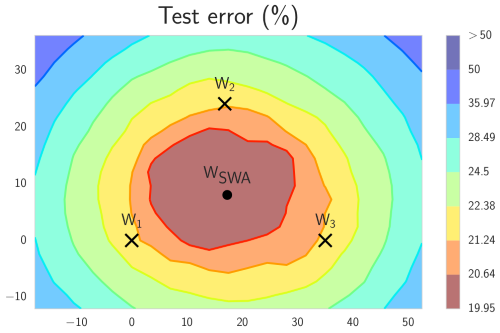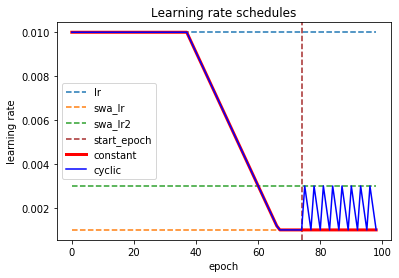This is an implemention of SWA for Keras and TF-Keras. It currently only implements the constant learning rate scheduler, the cyclic learning rate described in the paper will come soon.
Stochastic weight averaging (SWA) is build upon the same principle as snapshot ensembling and fast geometric ensembling. The idea is that averaging select stages of training can lead to better models. Where as the two former methods average by sampling and ensembling models, SWA instead average weights. This has been shown to give comparable improvements confined into a single model.
- Title: Averaging Weights Leads to Wider Optima and Better Generalization
- Link: https://arxiv.org/abs/1803.05407
- Authors: Pavel Izmailov, Dmitrii Podoprikhin, Timur Garipov, Dmitry Vetrov, Andrew Gordon Wilson
- Repo: https://github.com/timgaripov/swa (PyTorch)
pip install keras-swa
Keras callback object for SWA.
start_epoch - Starting epoch for SWA.
lr_schedule - Learning rate schedule. 'manual' , 'constant' or 'cyclic'.
swa_lr - Learning rate used when averaging weights.
swa_lr2 - Upper bound of learning rate for the cyclic schedule.
swa_freq - Frequency of weight averagining. Used with cyclic schedules.
batch_size - Batch size. Only needed in the Keras API when using both batch normalization and a data generator.
verbose - Verbosity mode, 0 or 1.
Last epoch will be a forward pass, i.e. have learning rate set to zero, for models with batch normalization. This is due to the fact that batch normalization uses the running mean and variance of it's preceding layer to make a normalization. SWA will offset this normalization by suddenly changing the weights in the end of training. Therefore, it is necessary for the last epoch to be used to reset and recalculate batch normalization for the updated weights.
The default schedule is 'manual', allowing the learning rate to be controlled by an external learning rate scheduler or the optimizer. Then SWA will only affect the final weights and the learning rate of the last epoch if batch normalization is used. The schedules for the two predefined, 'constant' or 'cyclic' can be observed below.
For Keras
from sklearn.datasets.samples_generator import make_blobs
from keras.utils import to_categorical
from keras.models import Sequential
from keras.layers import Dense
from keras.optimizers import SGD
from swa.keras import SWA
# make dataset
X, y = make_blobs(n_samples=1000,
centers=3,
n_features=2,
cluster_std=2,
random_state=2)
y = to_categorical(y)
# build model
model = Sequential()
model.add(Dense(50, input_dim=2, activation='relu'))
model.add(Dense(3, activation='softmax'))
model.compile(loss='categorical_crossentropy',
optimizer=SGD(learning_rate=0.1))
epochs = 100
start_epoch = 75
# define swa callback
swa = SWA(start_epoch=start_epoch,
lr_schedule='constant',
swa_lr=0.01,
verbose=1)
# train
model.fit(X, y, epochs=epochs, verbose=1, callbacks=[swa])Or for Keras in Tensorflow
from sklearn.datasets.samples_generator import make_blobs
from tensorflow.keras.utils import to_categorical
from tensorflow.keras.models import Sequential
from tensorflow.keras.layers import Dense
from tensorflow.keras.optimizers import SGD
from swa.tfkeras import SWA
# make dataset
X, y = make_blobs(n_samples=1000,
centers=3,
n_features=2,
cluster_std=2,
random_state=2)
y = to_categorical(y)
# build model
model = Sequential()
model.add(Dense(50, input_dim=2, activation='relu'))
model.add(Dense(3, activation='softmax'))
model.compile(loss='categorical_crossentropy',
optimizer=SGD(learning_rate=0.1))
epochs = 100
start_epoch = 75
# define swa callback
swa = SWA(start_epoch=start_epoch,
lr_schedule='constant',
swa_lr=0.01,
verbose=1)
# train
model.fit(X, y, epochs=epochs, verbose=1, callbacks=[swa])Output
Epoch 1/100
1000/1000 [==============================] - 1s 703us/step - loss: 0.7518
Epoch 2/100
1000/1000 [==============================] - 0s 47us/step - loss: 0.5997
...
Epoch 74/100
1000/1000 [==============================] - 0s 31us/step - loss: 0.3913
Epoch 75/100
Epoch 00075: starting stochastic weight averaging
1000/1000 [==============================] - 0s 202us/step - loss: 0.3907
Epoch 76/100
1000/1000 [==============================] - 0s 47us/step - loss: 0.3911
...
Epoch 99/100
1000/1000 [==============================] - 0s 31us/step - loss: 0.3910
Epoch 100/100
1000/1000 [==============================] - 0s 47us/step - loss: 0.3905
Epoch 00100: final model weights set to stochastic weight average



